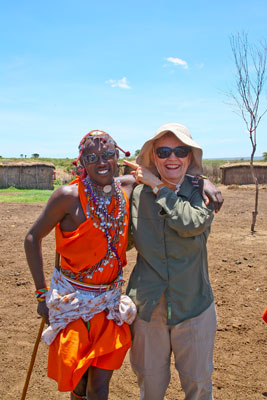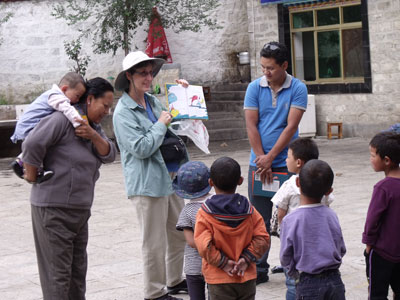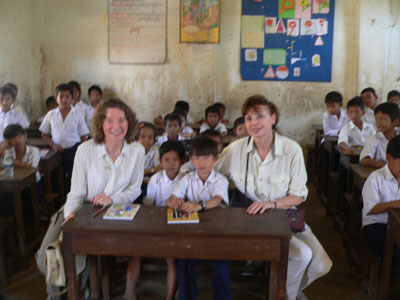Traveling and giving
Kevin O’Brien of Savannah, Georgia, wrote (July ’13, pg. 34 & Aug. ’13, pg. 17), “I would like to know what others do in the way of traveling to other countries and taking helpful gifts to leave behind… . On our travels, my wife, Jane, and I usually take one extra suitcase each. We pack toys, stuffed animals, school supplies and clothing, both for children and adults… . We check ahead of our trip and arrange to take things to an orphanage or some other charity. Sometimes the tour company in the foreign country helps us with this or I contact the hotel where we will be staying or, often, … a Catholic church… . We rarely give things to individual people or children on the street… . I find it is best to have someone in the country distribute what we brought.
“I would like to know (what other people) donate on their travels and… whether or not they have had any luck getting the airlines’ extra-bag fees waived. I also would like to know what special experiences travelers have had as a result of their giving.”
To Kevin’s queries, directed at subscribers traveling outside of the US, we added, “What types of items will be most appreciated in which countries? How did you decide who to leave them with? Where and approximately when did you do this?”
We’re printing some of the responses this month, with more to come. If you wish to share your experience or advice, write to Traveling and Giving, c/o ITN, 2116 28th St., Sacramento, CA 95818, or e-mail editor@intltravelnews.com (include the full address at which you receive ITN). Photographs are welcome; include captions.
For a tour to Nepal I organized with a small group of friends in 1992, the outfitter asked if we could bring any unwanted wool sweaters or down coats for the porters. At that time, there was no issue with taking two bags aboard a plane. I thought, ‘Great! I can fill a bag with the suggested items and bring back a bag with my purchases.’ I actually went to thrift stores to buy extra items.
I have no idea what conditions are like in Nepal now, but it was very rewarding to see the porters sort through the items and then wear them. I particularly remember one porter who had a long, lavender down coat, from a previous traveler, which he never took off.
From that time on, I have asked what I could take. For a trip to Tibet, the outfitter asked us to take toothpaste and brushes as well as pens. My dentist, through his toothpaste and toothbrush supplier, was able to provide as many as I could take, and the pens came from drug companies — very bright and colorful.
I also collected the soap bars from my hotels. The women loved them! They would smell them and then put them up to their faces, beaming.
On a prior tour I took to Tibet, one guy brought a View-Master with a number of reels. What a hit! He left it with a school in a remote part of the country. I’m sure many children enjoyed that wonderful object for years.
I have taken some personal items: sachets of lavender from my garden, plus pictures and small photo albums with postcards of Washington state.
To Botswana in October 2011 I took a soccer ball — a BIG hit — and recent soccer magazines. With the airlines’ bag restrictions, it is much harder to take anything useful in any quantity now unless money is no object, but even small items are appreciated as long as they are not junk. If you can’t think of anything to take, just ask your tour operator.
Joyce Renee Lewis
Camano Island, WA
My husband, Steve, and I took a group tour to Kenya and Tanzania with a tour company (now defunct) in 2008. A friend suggested taking a few things to give to the children of the Maasai villages we would be visiting. I promptly went to the dollar store and bought shampoo, toothpaste, soaps, brushes, combs, mirrors, sunglasses, lotions and school supplies of all kinds.
I then went through our closets and pulled out baseball caps, slightly worn tennis shoes and socks. Being a retired cosmetics buyer, I had samples of creams, colognes and other potions. My brother-in-law was traveling with us, and he went to Costco and stocked up on small, nonperishable items of food (but not candy).
We always travel carry-on, so the huge, inexpensive suitcase went free.
When we got to the first of two villages, this one in Kenya’s Maasai Mara, we told the leader we had some things to give to the children. Before I knew it, they all were lined up in a long row, very quietly awaiting their goodies.
Shortly after, one of the young men asked me if I wanted my picture taken with him, and when I got close to him I said, “Whoa, you got the cologne!”
He, very politely, said, “Yes. Do you have any more?”
School supplies were greatly appreciated, as we visited a schoolhouse in the Maasai encampment and all they had was a chalkboard.
When shopping in the curio shops, the salespeople would gladly trade anything we wanted for anything from America, but, as they all had jobs, I felt the children needed the items more than they did.
Claudia Reed, Las Vegas, NV
My husband and I travel with just carry-ons. We each have a backpack for under the seat in front of us and a rolling bag that easily fits into the overhead bin.
We have used our free “checked baggage” allowance on international flights for a box of school supplies. On our May 2012 Amazon River cruise, we had taken enough — according to our guide — for a whole village school.
Diane Robbins, Penfield, NY
Gifts for children are an integral part of travels with Overseas Adventure Travel (Cambridge, MA; 800/955-1925, www.oattravel.com). The trick is to take gifts that are “light and useable.”
In 2010 my wife, Karen, and I went to Mongolia and China with OAT. As a gift, I took a Frisbee with “KANSAS” written on it in permanent ink, and it turned out to be a hit with a 12-year-old nomadic girl in Mongolia, where outdoor space is plentiful. (In China, because of a lack of space, it was not a good idea.)
Karen took Dr. Seuss books. English has become THE international language, and Dr. Seuss books are great introductions to English for children of any culture.
Rod Smith, Oskaloosa, KS
Overseas Adventure Travel (Cambridge, MA) asks tour members NOT to give away anything sweet in countries that lack dental care. I traveled with OAT to Kashmir and Ladakh in 1989.
A cartoon in my dentist’s office reads, “Support your dentist: eat candy.” In some countries, this is no joke.
Jon Lafleur, Kent, CT
My husband, Bernard, and I traveled to Thailand and Laos in February 2010 with Mekong Tours (Tillamook, OR; 503/842-7198, www.mekongtours.com) on a tour led by Dr. Robert Phillips. A few days before departure, we received an email from Robert requesting that everyone bring about 10 pairs of reading glasses purchased at any dollar store.
Near the beginning of our tour, we left posters in Nam Neun, Laos, stating that we would be returning in a week to distribute free glasses. We had about 200 pairs to give out.
It was a very rewarding experience watching the people as they tried on the glasses. One lady had tears running down her cheeks. She put her hands over her heart and then approached us, putting her hands on our hearts. One member of our group even gave away his personal reading glasses when we ran out.
This was the first time this guide had tried his “See the World” program. It was quite successful!
I took several Polaroid pictures, giving them to the individuals in the pictures. (Polaroid film may be purchased on the Internet, plus there is now a digital Polaroid camera available, though its pictures are much smaller than they used to be.)
Taking a picture of a classroom of children and/or the teachers and leaving it with them is a treat. At one school near Bagan in the hills of Myanmar, the teachers were thrilled to have their pictures taken, one for each teacher.
Bernard and I usually take items for schools or orphanages, such as pencils, pens, chalk, washable markers, paper, books, soap, shampoo and perhaps some cheap candy, and then we purchase a soccer ball or similar and jump ropes, things with which students can interact with one another.
Maps of the USA or the state from which one comes, along with some family pictures, are appreciated. Something from one’s area, such as our Minnesota wild rice along with cooking instructions, or a sample-size perfume, lipstick or deodorant or a homemade item makes a memorable gift for a hostess.
Near the end of a tour, we will leave our medicinal items (such as Pepto-Bismol, hygienic items, etc.) at an orphanage or school or with a village administrator.
Traveling in a small group with Dr. Phillips, we never knew what might happen. He might purchase a chicken at the local market to give to a new bride and groom at their wedding reception or he could purchase books and paper for a school.
He goes into the heart of a country, where many other tour groups do not venture.
Margaret (Peg) Sonnek
Easton, MN
For a trip to India in 2013, I selected a number of clothing items that were perfectly nice but not my favorites. After wearing them on the trip, I folded them up and put them on the edges of the trash cans in my hotel rooms (because if you leave things in other places in your room, the attendants usually chase you down to return them).
I left a number of nice garments and, at the end, even my shoes. I figured someone would enjoy the nice garments, plus I made space in my suitcase.
At a visit to a school, I noticed a boy admiring the small flashlight I had attached to my handbag. I was going to give it to him but decided to first check with our guide, Girish. He said, “Absolutely not,” because it would cause a riot, as the other children would be without.
Our group contributed to the school so they could best use the money as needed.
Lana Weber, Spokane, WA
My perspective is that of a tour company operator, photojournalist and frequent volunteer translator on medical missions abroad.
Much of the world has been taught by well-intentioned tourists to beg for money, candy, pens, toys, lipstick and trinkets. This type of giving belittles the people, erodes the local culture, perpetuates a negative stereotype of patronizing foreigners, and creates reliance on begging. It also encourages parents to exploit their children by sending them out to beg from tourists instead of going to school.
In order to preserve the cultures that our groups visit, we enforce a strict policy against this type of giving. Instead, we encourage participants to focus on cultural interactions by smiling, making friends and learning a few basic phrases in the local language. They also are encouraged to support the local economy by purchasing handicrafts.
For those interested in contributing to positive, sustainable change in a systematic, meaningful way, our local agents at each destination can help. They are happy to share their contacts with foundations and nongovernmental organizations (NGOs) that can provide an understanding of the locals’ needs and the best way to address those needs.
By following these suggestions, our presence in some wonderful places around the world will not endanger their cultures and traditions.
Debbie Jefkin-Elnekave
Paia, HI
My sister Yarka Cleary and I traveled to Cambodia in December 2009, hired a driver, parked ourselves at a hotel halfway between the entrance to the monuments of Angkor Wat and the bustling town of Siem Reap for six days and traveled around, not only visiting some 20 temple sites but doing a little bit of good.
We asked our driver, who happened to have an 8-year-old boy, if we could contribute in some small way, perhaps to his boy’s classroom. He thought that was a good idea, as this was a public school with children from extremely poor backgrounds.
We asked him to take us not to a tourist souvenir shop but to the store where he bought his boy’s school supplies, knowing that our dollars would go much further there.
We asked how many kids there were in the classroom. There were about 40, so we bought 40 notebooks, 80 pencils, 40 colorful erasers and 40 pencil sharpeners, all for $25 (the price of a 30-minute massage for one at our hotel — easily forfeited).
The next morning we were met by our driver’s son at the schoolyard gate and led to his classroom in a single-story cinderblock building. We unpacked our supplies in front of the class and then went down the rows of desks, letting each child pick out the items.
In return, we got a 32-voiced ‘Thank you.’ (Some kids were absent but still would get the supplies from the grateful teacher.) We were touched almost to tears. We couldn’t have asked for a better experience for the measly $25.
Why pay the airlines luggage fees to take things to a third-world country when that same amount can buy so much more once you arrive? In addition, you help a local merchant. Also, giving directly eliminates any doubt that the goods truly go to the needy.
Emmy Allgood
Fremont, CA




